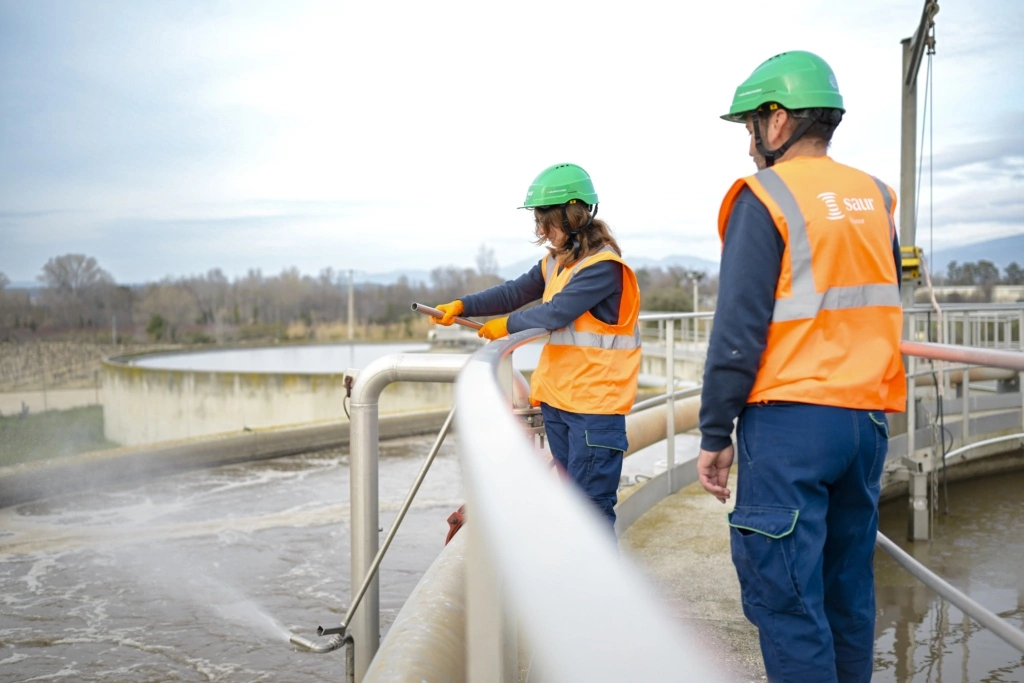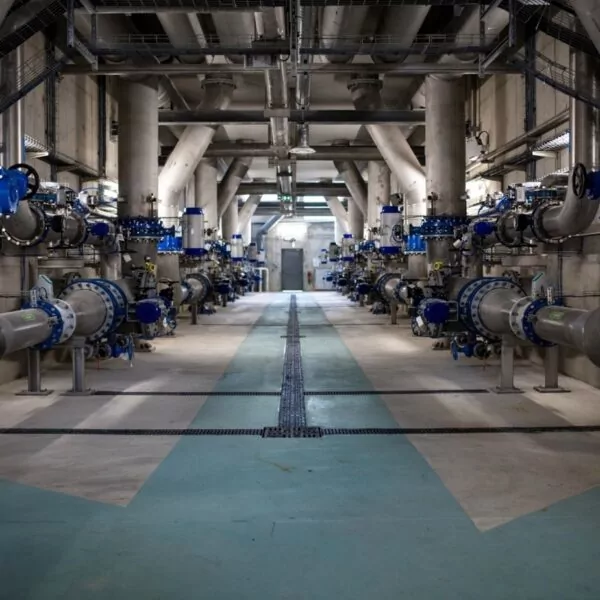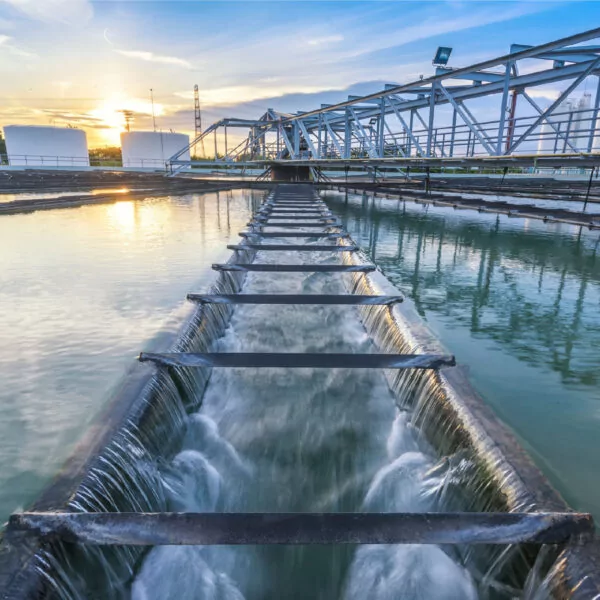What are PFAS? Definition and origins
PFAS (per- and polyfluoroalkyl substances) are known as “forever chemicals”. Widely used since the 1950s in a multitude of industrial applications but also in a wide variety of everday consummer products, they are found in water, air, and soil. They are extremely persistent and accumulate both in the environment and in living organisms.
The issues related to PFAS are numerous and complex. These substances are associated with many adverse health effects, such as hormonal disorders, cancers, and damage to the immune system.
Given their harmful effects on human health and ecosystems, it is essential to take action.
They are a group of over 10,000 synthetic chemical compounds used since the 1950s. They are commonly found in:
- Firefighting foamsWaterproof textiles
- Non-stick
- cookware
- Food packaging
- CosmeticsAt the molecular level, PFAS contain a highly stable carbon-fluorine bond, making them extremely persistent in the environment and nearly impossible to break down naturally. This is why they are often referred to as “forever chemicals.”
Why are PFAS so concerning?
PFAS pose several major risks:
- Environmental: They contaminate water, soil, air, and ecosystems—even in polar regions.
- Human health: Some PFAS are linked to cancer, endocrine disruption, immune system issues, and fertility problems.
- Bioaccumulation: They build up in living organisms and spread throughout the food chain.
European and French regulations: thresholds to meet by 2026
The European Directive 2020/2184, transposed into French law by the decree of December 30, 2022, mandates:
- A limit of 100 ng/L (0.1 µg/L) for the sum of 20 PFAS in drinking water (EDCH).
- Stricter thresholds for other micropollutants: bisphenol A, chlorates, uranium, pesticide metabolites.
- Mandatory monitoring starting January 1, 2026, as part of the national sanitary control program.
For industries, specific restrictions on aqueous discharges under the ICPE (Classified Installations for Environmental Protection) framework.

Your challenges
Communities and industries across Europe are increasingly facing the challenge of PFAS contamination in their drinking water and wastewater. Addressing this issue requires a clear understanding of four key areas: detection and monitoring, regulatory compliance, treatment and removal, and transparent risk communication. Each plays a vital role in protecting public health.
Municipalities
- Must be compliant by 2026.
- Need to invest in adapting or upgrading treatment infrastructure.
- Face increasing public and media pressure.
- Risk financial penalties in case of pollution.
- Are responsible for public health and maintaining user trust.
Industries
- Brand image can be severely damaged in the event of contamination.
- Polluter-pays principle increases their legal liability.
- Remediation costs can be high.
- Operational shutdowns or legal disputes may occur in case of non-compliance.
Contact our experts
How can the Saur group meet your needs?
PFAS Resolve offers a complete and modular approach to help anticipate regulatory requirements.
-
PFAS and micropollutant analysis campaigns
- Analysis of both raw and treated water.
- Measurement of the 20 regulated PFAS and, optionally, 27 additional PFAS.
- Cofrac-certified sampling and full logistics.
- Results in under 30 days with expert summary.
- Identification of future treatment needs.
-
Consulting and regulatory expertise
- Compliance audits for PFAS and micropollutant thresholds.
- Health and environmental risk assessments.
- Implementation of the Water Safety Plan (PGSSE).
- Investment prioritization for 2026.
-
Pilot projects and on-site testing
- Mobile treatment units to test different solutions.
- Comparison of technologies: activated carbon, ion exchange resins, reverse osmosis, electro-oxidation, SCWO, nanofiltration.
- Techno-economic analysis to determine the optimal treatment line.
-
Design and construction of treatment units
- Custom solutions for drinking water or wastewater treatment plants.
- Integration into existing infrastructure.
- Proven technologies: CarboPlus®, nanofiltration, electro-oxidation.
-
Operation and maintenance
- Continuous analytical monitoring.
- Preventive and corrective maintenance.
- Performance optimization.
- Real-time biosurveillance with Biosentinel® by Saur.

PFAS: understanding to act – Essential insight for engaged communities
PFAS: acting today to protect tomorrow – Industries at the heart of solutions
Discover more details on PFAS and its impact on water
White paper on micropollutants and PFAS: challenges and action plans for local authorities
DownloadOur solutions
Explore Saur’s comprehensive PFAS Resolve offer, from detection and compliance to treatment, mobile water solutions, and community support.

- Municipal
CARBOPLUS® Drinking water
- Drinking water
- Micropollutants
- PFAS Resolve
CarboPlus® is a patented drinking water treatment process using suspended activated carbon to remove micropollutants.

- Municipal
CARBOFLUX® Drinking water
- Drinking water
- Micropollutants
- PFAS Resolve
- Rainwater
CARBOFLUX® is a patented process designed to address the operating constraints of water types that are difficult to treat, such as water from lakes or reservoirs that are highly (...)

- Municipal
Reverse osmosis
- Drinking water
- Wastewater
The reverse osmosis technology developed by Saur is an advanced membrane filtration process that produces high-quality water by removing dissolved salts, micropollutants, and other (...)

- Municipal
PFAS analysis campaigns
- Drinking water
- Wastewater
- Micropollutants
- PFAS Resolve
PFAS, or per- and polyfluoroalkyl substances, are a vast group of over 4,000 synthetic chemicals developed in the 1950s. Known for their water, grease, and stain-resistant properties, (...)

- Municipal
PFAS pilot testing
- Drinking water
- Micropollutants
- PFAS Resolve
- Wastewater
With PFAS emerging as a major public health and regulatory concern, municipalities must prepare for the 2026 drinking water compliance deadlines. A PFAS pilot project allows local (...)

- Municipal
Aeroflux®
- Drinking water
- Wastewater
Aeroflux® is a dissolved air flotation (DAF) clarification process designed to effectively remove organic matter and algae from surface waters.
Contact our experts
FAQs
PFAS are per- and polyfluoroalkyl substances, a family of synthetic chemicals used in many industrial and household products.
Because they are chemically stable and barely degrade in the environment, accumulating over time.
In drinking water
In soil and groundwater
In the air
In food
In everyday products: packaging, textiles, cosmetics
PFAS can cause:
- Certain cancers
- Endocrine and immune system disorders
- Fertility and developmental issues
PFOA, PFOS, PFNA, and PFHxS (the “PFAS4”) are the most tracked due to their persistence and toxicity.
Mainly through:
- Soil infiltration
- Industrial discharges
- Poorly treated wastewater
Starting in 2026: 100 ng/L (0.1 µg/L) for the sum of 20 PFAS in drinking water.
Some are already banned, and others are being phased out in the EU and other countries.
Using liquid chromatography coupled with mass spectrometry (LC-MS/MS).
Yes, using:
- Activated carbon filters
- Ion exchange resins
- Reverse osmosis
A patented Saur technology using fluidized activated carbon to effectively remove PFAS.
A real-time biosurveillance system based on the behavior of live organisms, developed by Saur.
It depends on the water source and the producer’s quality controls.
-
- Regulatory non-compliance
- Financial penalties
- High treatment costs
- Loss of public trust
-
- Legal and financial risks
- Reputational damage
- Potential shutdowns in case of pollution
By launching:
- PFAS analysis campaigns
- Compliance audits
- Pilot projects
Yes, especially for ICPE and wastewater treatment plants.
No, each site requires a tailored diagnosis and treatment line.
From a few months to over a year, depending on infrastructure size.
-
- Recognized expertise in water treatment
- Innovative technologies (CarboPlus®, Biosentinel®)
- End-to-end support from diagnosis to operation